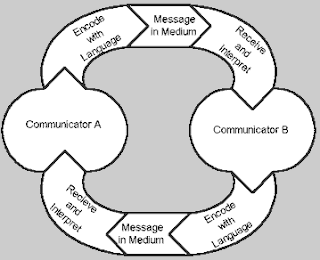Each and every conversation or type of communication that occurs between people can be broken down into standardized and universal parts. These elements of communication make up basic communication theory. Any individual who is seeking to become a more effective and clear communicator should learn all they can about these basic elements of communication and constantly be aware of them in their conversations and communication.
I have created a model for a previous assignment that outlines these basic elements of communication theory. I have titled this model the "DNA Model of Communication" and it can be viewed below. Following the image is a detailed description of the various aspects that are illustrated in the model. 
Please click on this image in order to view it clearly
Source/Receiver:
The two strands of DNA in this model represent the two people who are communicating with one another. Since communication is almost always multi-directional, both individuals are at the same time the source and the receiver. The source refers to the person with whom the communication is originating and the receiver refers to the person who is hearing the communication. In the case of a conversation, both individuals are originating communication and receiving communication.
Encoding/Decoding:
The various items between the two strands of DNA represent all aspects of communication that is occurring between the source/receivers. First of all, there is the process of encoding and decoding. This process is very important to be aware of because it aids in understanding how messages are interpreted and understood by the other person. Encoding is the process by which the source puts the message or information that they want to communicate into words, the source chooses the words that they feel best communicate their message. Decoding is the process by which the receiver hears the message that the source has communicated and breaks down the message into parts that are logical for them to understand. In effective and clear communication, the encoding and decoding processes should mirror each other so that the message that the source is communicating is clearly heard and understood by the receiver. Unfortunately, this is often not the case. The way that an individual encodes and decodes a message depends on many factors, and each person will encode and decode slightly differently from everyone else. Especially when it comes to communication across genders, ages, languages, classes or people groups, the process of encoding and decoding can often lead to miscommunication or misunderstanding.
 Noise:
Noise:The interference in the encoding/decoding process is referred to as noise. Noise can take on a number of different forms and examples will be given in a later post. Some possible sources of noise come from an individual's culture, family background, education, and language. Noise can also be external physical noise that prevent the message from being heard properly. Other sources of noise are psychological and spiritual. Especially when it comes to communicating the Gospel, spiritual noise is present that will attempt to prevent the message from being received.
 Messages:
Messages:In addition to the encoding/decoding verbal process of communication, there is other communication that is occurring between the two individuals; this communication is referred to as messages. Messages are all of the non-verbal communication that is occurring. This can include gestures, body language, tone, eye contact etc. When communicating, it is important to be aware that only a small percentage of what you are communicating with another person is verbal. Awareness of the way you are communicating non-verbally will allow you to become a better, more clear communicator.
Context:
The physical context where communication is taking place also plays a role in the communication process. Some communication is only appropriate to occur in certain settings. For example, sensitive personal information should only be discussed in a private setting where the individuals feel comfortable and at ease. Context also matters for evangelistic communication. Sometimes it is important to speak to people 'on their turf', while at other times it is better to remove people from their situations and/or peers in order to better communicate with them. Again, when it comes to communication it is important to be aware of the context in which communication is taking place to make sure that the context will not hinder communication in any way.
Competence:
During communication it is also important to ask yourself whether or not the other person is understanding what you are saying. If competence is not being attained, it is important to alter what you are saying in order to be understood. Competence might be an issue when you are speaking to someone who has a different first language from you or when you are speaking to someone who is younger or not as educated as you. When it comes to communicating the message of Christianity, competence can become an issue if you are using too much Christian language or phrases.
Feedback:
When it comes to communication, feedback is in a sense the last and most important step. This step is where you make sure the other person has understood you. Feedback may involve asking questions to gauge competence, asking for a response, or any other method whereby you ascertain if your message has been properly received. Communication generally demands a response and so that fits under this label.
Other Models of Communication:

















 As we grow in intimacy with others, the importance of communication grows!
As we grow in intimacy with others, the importance of communication grows!
